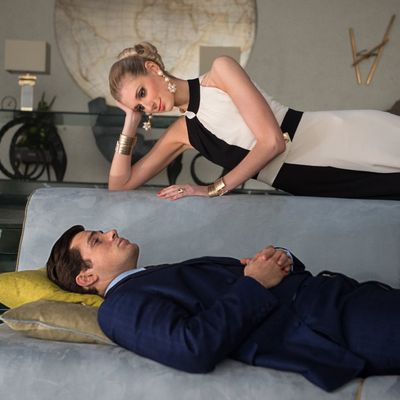
The Man From U.N.C.L.E. is a naked attempt to assemble another studio “franchise” (my least favorite word, except when applied to 7-Eleven stores and Sunoco stations) from a good (at its best) but irrelevant half-century-old TV espionage show, starring two barely distinguishable hunks-of-the-moment and directed by the guy behind the coarse, whoosh-y Sherlock Holmes–as-action-hero “franchise” fashioned for the newly charmless Little King, Robert Downey Jr. Though I strive to set aside all prejudices when the lights go down, I had a hunch that The Man From U.N.C.L.E. would be excruciating.
Well, it turns out to be absolutely delightful. Which proves again the folly of making up one’s mind about what one hasn’t seen.
It must be said that the whoosh-meister, Guy Ritchie, is not working in his usual key. Setting his film in a snazzy early ‘60s, he has decided that style will be substance and has the stylishness to pull it off. The Man From U.N.C.L.E. is not another jittery, rattle-you-into-submission post-Bourne thriller. It’s not even, truth be told, especially thrilling. It’s something more rare these days. It’s breezy and elegant — so breezily elegant it can make you laugh out loud from frame to frame.
It takes its tone from its protagonist, Henry Cavill’s Napoleon Solo, a former master-thief blackmailed by the CIA (represented by a nasty-raspy Jared Harris) into becoming a secret agent. Cavill wears the best-fitting suits I’ve ever seen, all in shades of blue that bring out the radiance in his jet-black hair. The dimple in his chin might have been added by an artist. A Brit playing an American, Cavill delivers his smart-aleck lines in a resonant purr that is too musical to be coming from a Yank but perfectly abets this conception of Solo. He makes you think of the old-style Bond — and is plainly meant to.
The movie’s mismatched-buddy gimmick is that here, at the height of the Cold War (a gorgeous, post–World War II Soviet vs. U.S. montage is the backdrop for the credit sequence), Solo is forced to work with a former antagonist, KGB agent Illya Kuryakin, to fight a soon-to-be nuclear-armed criminal organization led by the tall, poised fox from The Great Gatsby, Elizabeth Debicki, this time insouciantly sinister. (She has snared a former Nazi nuke genius named — cheekily — Teller.)
This is not the enigmatic Kuryakin of TV’s golden-haired David McCallum. Armie Hammer’s Ilya is a softhearted if borderline-psychotic beast, an indefatigable terminator who has, like Solo, been blackmailed by his state. (His father languishes in the Gulag.) Physically, Hammer bears too much resemblance to Cavill, and I wish they’d lightened his hair to make him more distinctive. (He’d have looked great with the plutonium hues of Robert Shaw in From Russia With Love.) But he’s a good comic actor with bullying force — his hard stare fractures Cavill’s twinkle into wobbly particles.
Much excellent comic fodder comes from Solo and Kuryakin’s compulsion to one-up each other — in every way except, oddly, over the Girl, Gaby Teller, played by that lissome, versatile Swedish ex-ballerina Alicia Vikander, who brings a touch of Audrey Hepburn impudence to the part. No rivalry here: Babe-magnet Solo gets to bed the dishy hotel clerk and the villainess while Kuryakin makes time in his clumsy fashion with Gaby, who has joined the pair in an effort to contact her kidnapped father. The two have a kinky-weird scene in which they beat each other up and fall into a quasi-clinch — at which point she conks out in bed.
The emotional stakes don’t seem very high in The Man From U.N.C.L.E., in part because Ritchie (who co-wrote the screenplay with Lionel Wigram) doesn’t use revenge to fuel the plot. (Think how much more aimless Mission: Impossible — Rogue Nation would be if it didn’t begin with the villain putting a bullet at point-blank range into the head of a pretty, enthusiastic young agent in front of the helpless Tom Cruise.) The lone character who loses someone close is surprisingly blasé about it.
The emotion here comes from Ritchie’s evident love of choreographing things just so, which is retro in the best way. In an early car chase, two vehicles swerve and merge and move apart with dazzling symmetry. In another, the shots are held extra-long so the camera can pivot to show the spatial relationships between hurtling objects. Two of the most hilarious scenes show tumultuous happenings in the background — noiselessly, behind glass — while characters in the foreground are either serenely indifferent or oblivious. On a couple of occasions, Ritchie splits the screen, seemingly just for the fun of it. And he lingers happily on the high-tech trappings of a different age, now absurdly low-tech — but beautiful. This is the sort of movie where the cinematographer (John Mathieson), editor (James Herbert), and production (Oliver Scholl) and costume (Joanna Johnston) designers deserve their own curtain calls.
I don’t want to oversell The Man From U.N.C.L.E. It’s still a formulaic “origin story” with a plug for the “franchise” to come before the closing credits. But artifice this witty can give you a lot of pleasure. One aspect of the movie’s unreality is unexpectedly fun. Apart from Hugh Grant as Waverly, the lead actors use accents not their own: Brits Cavill and Harris play American, American Armie Hammer plays a Russian, and Swede Vikander and Aussie Debicki speak with from-nowhere “European” cadences. Rarely does absolute inauthenticity come across as so superbly stylized.


